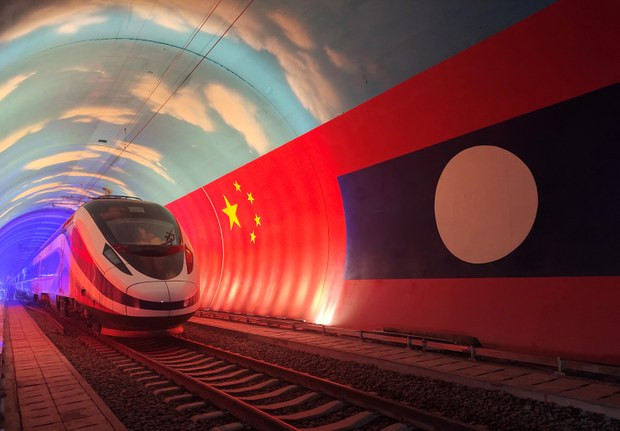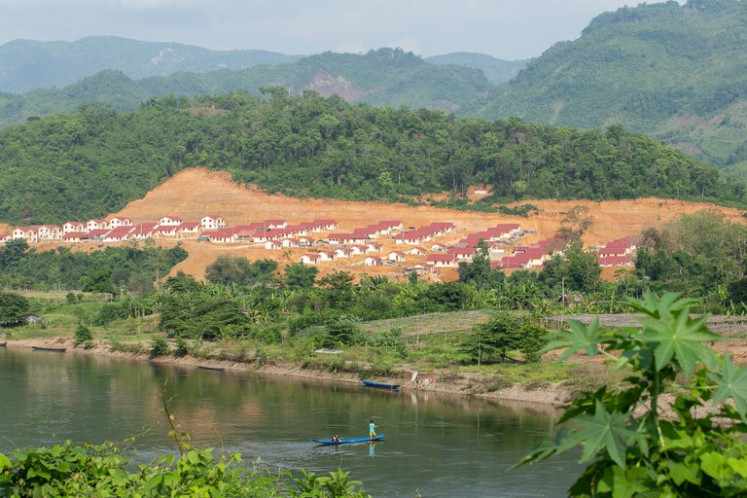Popular Reads
Top Results
Can't find what you're looking for?
View all search resultsPopular Reads
Top Results
Can't find what you're looking for?
View all search resultsLaos: Belt and Road poster child – or problem child?
Few nations have been transformed as radically by China’s Belt and Road Initiative, or BRI, as Laos. The US$5.9 billion China-Laos railway has pushed the small, Southeast Asian country closer to its dream of being land-linked, not land-locked.
Change text size
Gift Premium Articles
to Anyone
T
he high-speed train streaks above bright green rice fields and zips through tunnels in mountains of rural Laos. It cuts what is normally a days-long journey by car from Yunnan province in southern China across Laos to the Thai border to just three hours – and allows travel in comfort.
Few nations have been transformed as radically by China’s Belt and Road Initiative, or BRI, as Laos. The US$5.9 billion China-Laos railway has pushed the small, Southeast Asian country closer to its dream of being land-linked, not land-locked. Well-to-do Lao and Chinese tourists can traverse the country with ease.
But 22 months after the railway was opened in December 2021, the benefits of that investment are spread unevenly.
Among the nearly 7,000 families who impacted, many grumble they have lost out when they were resettled. And while some have benefited from economic development along the route of the railway, others tell Radio Free Asia, a news service affiliated with BenarNews, they are struggling to make ends meet.
The same goes for Laos as a nation. The railway and a host of other major Chinese investments in transport infrastructure and hydropower dams have left Laos mired in debt, which experts say is perilously high. About half of that debt is held by China.
Read also: Jokowi returns from China with billions in investment pledges
The resulting economic turmoil has left most Laotians struggling with high inflation, a depreciating currency and bleak prospects. Ratings agencies have warned that Laos could be heading for a default on loans from foreign lenders.
So as the BRI marks its 10th anniversary, has Laos gained or lost from its immersion in China’s grand plan to spread its infrastructure and investment across Asia and beyond?
Boon and bane
Noi, a 32-year-old from Vientiane who works in tourism, recently moved to the northern town of Vang Vieng to work at a luxury hotel. The decision to relocate was made easier thanks to the new railway connecting the two places.
“Though Vang Vieng isn’t as accommodating as Vientiane, the new railway convinced me to seize the job here. More tourists, more jobs,” Noi told RFA. “With all my family and friends in Vientiane, the train ensures I can easily visit them. Earlier, the trip was challenging, especially during rainy seasons due to poor road conditions.”
Noi is not the only one to benefit from the 422-km new railway. Data from the Laos Tourism Department for the first half of 2023 indicates over 1.6 million foreign visitors – up from just 42,000 during 2022, when the impact of the pandemic still lingered.
Thai, Vietnamese, and Chinese tourists make up the majority of visitors, with the Chinese portion expected to grow further.
“The project stimulates the tourism sector and local businesses immediately,” said a Lao economist who like many of the sources in this article declined to be named because of sensitivities in the one-party state of speaking to news media.
Somsavat Lengsavad, a former Lao foreign minister and deputy prime minister who was in the vanguard of promoting engagement with China, told a July forum in Vientiane that the BRI developed by President Xi Jinping and the Chinese government “reflected the attributes of a responsible leader.”
“Economic cooperation is growing based on the principle of mutual benefit, as demonstrated by the Laos-China Railway and other development projects,” Somsavat was quoted as saying by the state-run Vientiane Times.
But Toshiro Nishizawa, from the University of Tokyo’s School of Public Policy, said Laos lacks the skilled labor to reap the benefits of connectivity.
It could profit from high-end Chinese tourism, but Chinese companies tend to dominate that business, particularly in popular destinations like the old royal Lao capital of Luang Prabang, meaning local businesses will struggle to benefit from a surge in arrivals.
And when it comes to increased trade, of the more than 4 million tons of goods transported by the railway between December 2021 and May 2023, most of the agricultural exports to China are from Chinese companies established in Laos, not Laotian-owned businesses.
People living near the Laos-China Railway were moved to new villages, including this settlement in Buam Aor village, Xiang Ngeun district, Luang Prabang province, Laos, April 22, 2022. (Xinhua via Getty Images/Kaikeo Saiyasane)Unmet promises
China’s economic influence across its southern neighbor is pervasive, with major investments in roads, hydropower, agriculture and mining.
Although those projects have injected money into Laos and brought employment opportunities – from construction jobs to farm laboring – they have also been associated with environmental problems and community displacement.
The daddy of investment projects has been the railway. But for that, many villagers were pushed out of homes that had spacious farmland nearby to make way for track, stations, tunnels and bridges, and then relocated to more confined spaces within resettlement villages set up by the Lao-China Railway Co.
“We have houses to live in but no land. We have to climb a mountain to reach our old farms,” lamented one villager from Xieng Ngeun district in Luang Prabang province, who said that they have to walk at least two hours to farm rice.
By June 2023, the railway project had impacted 6,855 families across five provinces. The Lao government reports compensating 5,837 families with 1.4 trillion kip ($72 million), leaving 1,018 families yet to be properly compensated. Such discrepancies, along with insufficient compensation, breed discontent among those displaced, who often feel they lack the right to complain to authorities.
“If they really want to solve the problem of compensation to the people, they can do it easily,” said a Lao intellectual, referring to authorities. “We know well that in Laos, people cannot file an appeal against the state.”
China is also a key investor in hydropower, supporting Laos’ ambition to become the “battery of Southeast Asia” by selling electricity to boost foreign earnings.
One such project is the Nam Tha 1 dam, which displaced more than 10,000 people in Luang Namtha and Bokeo provinces. It’s a joint venture between China Southern Power Grid International Co. Ltd., with an 80% stake, and state-run Electricite du Lao holding the other 20 percent.
Read also: Batang Toru power plant project hits snag as orangutan conflict worsens
Displaced locals haven’t just lost their traditional homes and livelihoods. They also lament the loss of their heritage as the project flooded Buddhist temples in their old villages which they could not afford to dismantle and rebuild at their resettlement sites.
“We cannot move our respected Buddha statues,” a villager from Nalae district of Luang Namtha province said. “So, we just left them there.”
While new settlements have in some cases improved amenities for villagers, locations tend to be remote, leaving residents struggling to adapt to a new way of life.
An official familiar with the resettlements for various dam projects including Nam Tha 1 said efforts by Lao authorities and Chinese developers to encourage villagers to raise cattle and livestock instead of rice farming and foraging haven’t been as successful as hoped.
“It is hard to adapt to the new things in a new resettlement village” said the official, noting that people are used to relying “on nature or forest.”
Debt at ‘critical level’
The Lao government has leaned heavily on foreign assistance to support the economy for decades and now financial liabilities from mega projects have plunged the country deep into the red.
The World Bank said that by 2022, Laos’ public debt soared to 110% of its GDP, with about half of the external debt owed to China.
Jayant Menon, senior fellow with the Regional Economic Program at ISEAS-Yusof Ishak Institute in Singapore, said the latest International Monetary Fund estimate of Laos’ debt is even higher – about 123% of GDP, which is about three times what would be normally regarded as “substantial.”
“Therefore, the debt situation in Laos has reached a critical level,” he said.
He added that there’s no doubt “that debt from BRI is a major part of the problem” – including Laos’ 30% stake in the China-Laos railway.
Menon said that the interest rates on loans offered by China are higher than multilateral lenders like the Asian Development Bank, or ADB, and World Bank.
“But the advantage is that the conditionality is weaker. They (the Lao government) do not need to hold high standards on things like environmental or resettlement policy,” he said.
Read also: Govt allows state budget to guarantee loans for high-speed rail project
According to the ADB, Laos will need to manage annual public debt service payments of about $1.2 billion for the coming five years. A scholar who used to teach in Laos said its projected GDP for 2023 is only about $14 billion.
The scholar foresees not just problems making those payments but deepening economic woes should the national currency, the kip, continue its downward spiral. The kip has halved against the dollar in the past two years, leading to high inflation in its import-reliant economy. Prominent credit agencies also doubt Laos’ ability to address its financial obligations.
“The debt level is so high that there is probably no real restructuring formula to try to return Laos to a sustainable path,” said Menon. “There must be a haircut or debt forgiveness and the amount has to be discussed.”
“But the problem is that this is not the China model to allow debt forgiveness because China has difficulty with lending in many countries that are part of BRI.”
Symbiotic, but uneven relationship
So which nation benefits most from BRI in Laos – China or Laos?
Yoon Jin-pyo, professor of political science and diplomacy at Seoul-based Sungshin Women’s University, said the relationship is symbiotic but in a way that favors Beijing more.
“China has already reaped substantial benefits from the BRI in Laos,” he told RFA.
The railway offers China the first stage of a future high-speed rail link from Yunnan through Laos, Thailand and Malaysia to Singapore, which could further cement China’s status as the dominant trading partner with Southeast Asia.
In addition to growing political and economic influence, Chinese soft power is also on the upswing in Laos. Mandarin language studies are booming.
Read also: China may be hindrance in RI getting FTA with US on critical minerals
Laos’ benefit is harder to pin down. For the railway, it can be a conduit for commerce but has little of its own to trade to its neighbors beyond electricity and minerals.
The Lao economist expressed concerns about the country’s growing economic dependence on China, and the repercussions of an influx of Chinese investments and workers into the country – including challenges to law and order.
“Chinese communities in business settings tend to form close-knit bonds, leading to powerful networks. As these ties intensify, they can exert more influence, sometimes resulting in friction within Lao society. It’s evident in instances where Lao regulations are disregarded,” he said.
“When one nation leans excessively on another, it jeopardizes both its societal stability and its citizens,” he said. “I urge the Lao government to find balance in this relationship.”











